SPHIS Home » Research » COVID-19 Research
COVID-19 Research
Introduction
A team of UofL SPHIS researchers, led by Dr. Seyed Karimi, is projecting trends in COVID-19 cases in Kentucky using a model of epidemic dynamics called the susceptible-exposed-infectious-recovered (SEIR) model. The model allows for measuring the effect of a public health policy intervention to contain an infection.
Check back frequently for updates. In addition to improving the precision of the current projections with new data, the team is working on measuring changes in the transmission of the disease over time. They are also assessing the impact of different reopening scenarios on the trends of hospitalization and deaths.
Projecting COVID-19 hospitalizations in Jefferson County, KY, based on the uptake of vaccination among children ages 5 to 11
December 15, 2021

Even though children comprise a small proportion of the hospitalized population, they still have a considerable impact on the overall COVID-19 hospitalization rate. The purpose of this modeling study was to project COVID-19 active hospitalizations in Jefferson County, KY, for three scenarios based on the uptake of vaccinations in 5- to 11-year-olds, the most recently authorized age group for COVID-19 vaccination by the FDA. The scenarios included an expected, an accelerated, and a decelerated growth in 5- to 11-year-olds’ vaccination rate. The research team concluded that achieving higher than expected rates of vaccination among children can decrease hospitalizations in the next three months. The magnitude of the decrease is approximately two dozen daily. However, since it is expected that COVID-19 will continue to spread, social distancing and other COVID-19 protection measures (e.g., mask-wearing and limiting unnecessary mobility and large gatherings) must continue. Should they be relaxed, another “during vaccination surge” will occur and should be expected in the late December-January period, particularly when a more transmissible variant emerges.
Key Takeaways
This study shows that it is pivotal to vaccinate the 5−11-year-old age group as best as possible through the most age-appropriate avenues (e.g., in schools and pediatrician offices) to prevent hospitalizations in older individuals.
By vaccinating 40% of 5–11-year-olds in Jefferson County, the research team projects approximately 54 overall active hospitalizations by the end of December 2021, assuming no change in other mitigation factors.
However, if only 10% of the 5–11-year-olds are vaccinated, the team projects the number of active hospitalizations would double (approximately 127).
Fast forward to January 31 2022, Jefferson County would have nearly 4 times as many active hospitalizations due to COVID in a scenario with 10% of 5–11-year-olds vaccinated compared to a 40% vaccination rate in the 5 to 11 age group.
MORE INFORMATION
- Access the report published December 07, 2021.
A Review of the Article: Guerra and Guerra (2021), “Mask mandate and use efficacy for COVID-19 containment in U.S. States,” published by International Research Journal of Public Health.
September 15, 2021
A recent article by Guerra and Guerra (2021) attempted to measure the effect of U.S. states’ mask mandates on the growth rate of COVID-19 cases at the state level. They reported no “association between mask mandates or use and reduced COVID-19 spread in U.S. states.” This study was frequently downloaded and debated in the State of Kentucky and at the national level. For example, the May 2021 version of the manuscript was commented on 179 times and recommended by 20 readers on the medRxiv by 14 September 2021. By the date, its August 2021 version was commented on 170 times and recommended by medRxiv 55 readers. To address the confusion created by this publication, we extensively reviewed it from the perspective of experts in public health research.
Key Takeaway
We found this article poorly structured with a sketchy and biased description of the background and a seriously flawed methodology, and improper analysis hence a wrong conclusion with vital consequences.
MORE INFORMATION
- Access the report published in 2021.
Projecting COVID-19 Hospitalizations and Deaths under Scenarios of Vaccination in Jefferson County, Kentucky
March 6, 2021
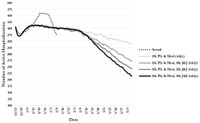
In February 2021, the total weekly number of doses of COVID-19 vaccines administered in Jefferson County, KY, was approximately 30,000. Receiving 30,000 doses of Pfizer and Moderna vaccines (15,000 of each dose) weekly was considered the status quo assumption scenario in this study. Then, scenarios of expanding the vaccination intensity were evaluated in two ways: (1) the county will receive 10,000 additional doses of Pfizer and Moderna vaccines weekly, and (2) doses of the Johnson & Johnson vaccine will be distributed and administered.
Key Takeaways
More intense vaccination than the status quo is expected to decrease hospitalizations and deaths in the next three months.
However, the magnitude of the decrease in deaths is small, < 3 dozen. Importantly, it is expected that the COVID-19 infection continues to spread.
Therefore, social distancing and other COVID-19 protection measures (for example, mask-wearing) must continue – should they be relaxed, a “during vaccination surge” will occur and should be expected in the late April-early May period.
MORE INFORMATION
- Access the report published March 06, 2021.
Results of the Third Observational Surveys of Mask Use in Indoor Public Areas in Jefferson County, KY, during January 25−31, 2021
February 8, 2021
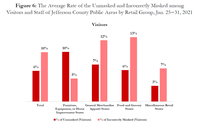
In the third wave of the observational survey of mask use in Jefferson County, Kentucky, 254 indoor public areas were observed. The research team concluded that the mask-wearing rate has decreased in the county, but the correct use of masks has increased. The rate of unmasked visitors and staff (majority are male) has significantly increased in the South & South West district, and incorrect mask-wearing is prevalent in the western districts. Not using a mask is more prevalent in public areas less than 5,000 square feet.
Key Takeaways
- The Mask-wearing rate has decreased in the county.
- Correct use of masks has increased in the county.
- The rate of the unmasked (among both visitors and staff) has significantly increased in the South & South West district.
- Incorrect mask-wearing has remained prevalent among visitors and staff of public areas located in western districts.
- Not using a facial mask has become more prevalent in smaller than 5,000 square feet public areas.
- The majority of the unmasked are males.
MORE INFORMATION
- Access the report published Feb. 08, 2021.
Results of the Second Observational Surveys of Mask Use in Indoor Public Areas in Jefferson County, KY during December 14−20, 2020
December 22, 2020
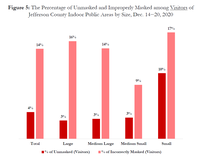 In the second wave of the observational survey of mask use in Jefferson County, Kentucky, the research team observed 382 indoor public areas. Over 83% of the public areas either checked mask-wearing or had mask use signs at the entrance. Forty-five percent of the public areas provided hand sanitizer to visitors (9% in the North West and 66% in the East and North East districts provided hand sanitizer). The research team found that 4% of visitors and 8% of staff did not wear a mask. Of those who did wear a mask, 14% of visitors and 13% of staff did not wear their masks properly. Males made up 60% of the unmasked and 53% of the improperly masked. Additional findings included:
In the second wave of the observational survey of mask use in Jefferson County, Kentucky, the research team observed 382 indoor public areas. Over 83% of the public areas either checked mask-wearing or had mask use signs at the entrance. Forty-five percent of the public areas provided hand sanitizer to visitors (9% in the North West and 66% in the East and North East districts provided hand sanitizer). The research team found that 4% of visitors and 8% of staff did not wear a mask. Of those who did wear a mask, 14% of visitors and 13% of staff did not wear their masks properly. Males made up 60% of the unmasked and 53% of the improperly masked. Additional findings included:
Key Takeaways
- Highest visitor unmasked rate: small public areas and the South & South West district
- Highest staff unmasked rate: medium-small public areas and the North West District
- Highest rate of improperly masked visitors: small public areas and the North West District
- Highest rate of improperly masked staff: medium-small public areas and the South & South West and West Center districts
- Mask use by sex: Men were 100% of the unmasked in the North West district and 74% of the improperly masked.
MORE INFORMATION
- Access the report published Dec. 22, 2020.
Projecting COVID-19 Hospitalizations for Regions 2, 3, and 4 of the Kentucky Regional Hospital Preparedness Program (HPP) Coalition during the Implementation of the State’s “Targeted Measures”
November 30, 2020
On Nov. 18, Gov. Andy Beshear announced that Kentucky would implement new restrictions for restaurants, schools, indoor social gatherings, gyms/fitness centers, and schools in Kentucky. The SPHIS COVID-19 Projection Team investigated how these targeted measures could affect hospitalizations due to COVID-19 in three regions of Kentucky:
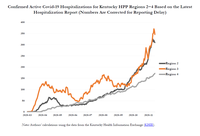
- Region 2 includes 11 counties (Daviess is the largest) and has an estimated population 374,030.
- Region 3 includes 15 counties (Jefferson is the largest) and has an estimated population 1,286,637.
- Region 3 includes 10 counties (Warren is the largest) and has an estimated population 308,919.
The study found that mid-range and high compliance with the new restrictions is projected to prevent excess hospitalizations and will allow the regions’ hospitals to operate elective surgeries at normal capacity. Projections also showed that without the new measures, the number of active hospitalizations in Region 2 would exceed the number of inpatient beds by mid-January 2021.
MORE INFORMATION
- Access the report published Nov. 30, 2020.
Projecting COVID-19 Hospitalizations and Deaths for Region 3 of the Kentucky Regional Hospital Preparedness Program (HPP) Coalition
November 20, 2020
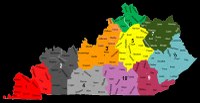 The research team was asked to estimate how Kentucky's newly implemented targeted measures could affect hospitalizations and deaths in Region 3 of the Kentucky Regional Hospital Preparedness Program (HPP) Coalition. Region 3 includes Jefferson County and 14 Surrounding Counties
The research team was asked to estimate how Kentucky's newly implemented targeted measures could affect hospitalizations and deaths in Region 3 of the Kentucky Regional Hospital Preparedness Program (HPP) Coalition. Region 3 includes Jefferson County and 14 Surrounding Counties
The study found that compliance with new restrictions is projected to prevent excess hospitalizations and deaths. In contrast, in the absence of (or no compliance with) new restrictions, the number of active hospitalizations and total deaths is expected to be 789 and 1092 by mid-December 2020. Projections also show that without the new measures, the number of active hospitalizations and total deaths is expected to be 1689 and 1932 by mid-January 2021.
Key Takeaways
- High compliance with the targeted measures (if it reduces transmission rate by 75%) prevents ~690 excess hospitalizations and ~194 deaths by mid-December 2020 and ~1,582 excess hospitalizations and ~970 deaths by mid-January 2021.
- Even low compliance with the targeted measures (if it reduces transmission rate by 25%) prevents ~355 excess hospitalizations and ~98 deaths by mid-December 2020 and ~933 excess hospitalizations and ~513 deaths by mid-January 2021.
- Mid-range compliance with the targeted measures (if it reduces transmission rate by 50%) prevents ~574 excess hospitalizations and ~155 deaths by mid-December 2020 and ~1,363 excess hospitalizations and ~828 deaths by mid-January 2010.
MORE INFORMATION
- Access the report published Nov. 20, 2020.
Results of the Observational Surveys of Mask Use and Protective Measures of Indoor Public Areas in Jefferson County, KY during November 5−11, 2020
November 17, 2020
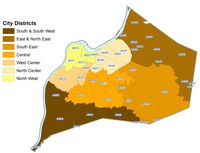
A new report summarizes an observational study of mask use and protective measures in indoor public areas (PAs) of Jefferson County, Kentucky. Surveyors observed 191 indoor public areas during the first wave of data collection: November 5-11, 2020. Surveyors observed the protective measures and mask-wearing behaviors at randomly selected businesses. Researchers also accounted for business type, size, and location in their study design. The study, funded by the Louisville Metro Department of Public Health & Wellness, will be conducted in multiple waves.
Key Findings
- The level of protective measures available at Jefferson County indoor public areas is low. Protective measures include providing hand sanitizer, sanitizing shopping carts, having a separate entrance and exit, checking visitors’ mask-wearing at the entrance, and providing masks or wipes to visitors.
- It is common to see unmasked staff and visitors in public areas, and even more common to see incorrectly masked staff and visitors in public areas.
- Unmasked staff and visitors in Jefferson County public areas are more commonly 19−44-year-old men.
MORE INFORMATION
- Access the report published Nov. 17, 2020.
Mobility Trends in Jefferson County, KY: February 15 to October 18, 2020
October 25, 2020
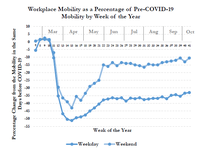 Dr. Seyed Karimi studied Google mobility indicators, which indicate the number of people going to work has been continuously increasing while residential and grocery store visits have been continuously decreasing from early September 2020.
Dr. Seyed Karimi studied Google mobility indicators, which indicate the number of people going to work has been continuously increasing while residential and grocery store visits have been continuously decreasing from early September 2020.
MORE INFORMATION
- Access the report published 10-22-2020.
Projecting COVID-19 Deaths and Hospitalizations for Region 4 of the Kentucky Regional Hospital Preparedness Program (HPP) Coalition from August 18 to October 17, 2020
Sept. 2, 2020
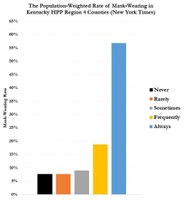
Dr. Karimi and his colleagues produced this report as part of the team’s collaboration with the Kentucky's Office of Health Data and Analytics, based in the Cabinet for Health and Family Services, and the Kentucky Regional Hospital Preparedness Program (HPP) Coalition. The HPP Region IV consists of ten counties: Allen, Barren, Butler, Edmonson, Hart, Logan, Metcalfe, Monroe, Simpson, and Warren. Warren County includes the city of Bowling Green, the third largest city in Kentucky. The analysis looked out how different rates of mobility and mask-wearing among Region IV residents would affect hospitalizations and deaths. The mask-wearing rate in the region is significantly lower and mobility rates are noticeably higher than those in Jefferson County, for which this research group predicted COVID-19 hospitalization and deaths previously. Also, COVID-19 hospitalizations in this region have been increasing from the beginning of the pandemic. Researchers found that increasing mask wearing is projected to prevent excess hospitalizations and deaths; however, the estimated benefits of increasing mask wearing will be attenuated if mobility increases at high rates. They conclude that mask wearing cannot/will not be able to mitigate high mobility rates.
MORE INFORMATION
- Access the report published 9-2-2020.
Projecting the COVID-19 Deaths and Hospitalizations for Jefferson County, Kentucky from July 16 to September 15, 2020
July 31, 2020
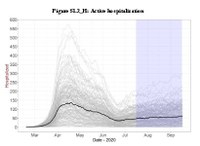
The focus of this report is showing the importance of mask-wearing in managing the number of hospitalizations and preventing additional deaths. Researchers examined moderate and high increases in the mask-wearing rates following the July 10 mask order, the possibility of the order’s reversal, and increases in mobility with the reopening of schools and universities.
Figure S1.2_H (shown left) illustrates the scenario with the greatest compliance with preventive strategies: mask-wearing compliance (i.e., local mask order in effect) and no significant change in mobility (i.e., schools remain closed). This scenario projects that by mid-September, Jefferson County would have approximately 70 active hospitalizations and 270 total deaths. These projections are lower than the study’s status quo scenario (no change in mask-wearing or mobility rates), which shows the number of active hospitalizations increasing to approximately 260 by mid-September.
If the mask order is reversed after a moderate increase in mask-wearing rate and school opening results in a high increase mobility, the numbers of active hospitalizations and total deaths can increase to approximately 350 and 400, respectively, by mid-September. Projections under this scenario are depicted in Figure S6.1_H in the report.
MORE INFORMATION
- Access the report published 7-31-2020.
Projecting the COVID-19 Weekly Hospitalizations and Deaths for Jefferson County, Kentucky
May 13, 2020
 More precise data has informed a second modeling study produced by the UofL School of Public Health and Information Sciences and the Louisville Metro Department of Public Health & Wellness. The updated projections show a current plateau in hospitalizations, along with a slight decrease in death rates and a significant decrease in hospitalizations by the end of August, compared to the first report published a couple of weeks ago.
More precise data has informed a second modeling study produced by the UofL School of Public Health and Information Sciences and the Louisville Metro Department of Public Health & Wellness. The updated projections show a current plateau in hospitalizations, along with a slight decrease in death rates and a significant decrease in hospitalizations by the end of August, compared to the first report published a couple of weeks ago.
MORE INFORMATION
- Access the report published 5-13-2020.
- Read the article about the report.
Projecting the COVID-19 Weekly Deaths, Infections, and Hospitalizations for Jefferson County, Kentucky
April 23, 2020
 A new modeling study by the UofL School of Public Health and Information Sciences and the Louisville Metro Department of Public Health & Wellness indicates that stringent social distancing measures the city put in place in March have significantly slowed the spread of COVID-19 in the city.
A new modeling study by the UofL School of Public Health and Information Sciences and the Louisville Metro Department of Public Health & Wellness indicates that stringent social distancing measures the city put in place in March have significantly slowed the spread of COVID-19 in the city.
MORE INFORMATION
- Access report published 4-23-2020.
- Read the article about the report.
Research Team
Seyed Karimi, PhD, Assistant Professor, Department of Health Management & System Sciences; Health Economist, Louisville Metro Department of Public Health & Wellness;
Natalie DuPre, ScD, Assistant Professor, Department of Epidemiology and Population Health
W. Paul McKinney, MD, Professor and Associate Dean, Department of Health Promotion and Behaviorial Sciences
Bert Little, PhD, Professor, Department of Health Management & System Sciences
Riten Mitra, PhD, Associate Professor, Department of Bioinformatics and Biostatistics
Naiya Patel, MPH, PhD student, Department of Health Management & Systems Sciences
Hamid Zarei, PhD Student, Department of Health Management & System Sciences
YuTing Chen, MPH, MS, Center for Health Equity, Louisville Metro Department of Public Health & Wellness
Sarah Moyer, MD, MPH, Director, Louisville Metro Department of Public Health & Wellness; Assistant Professor, Department of Health Management & System Sciences
Bakeerathan Gunaratnam, PhD, Assistant Professor, Department of Bioinformatics and Biostatistics
Giang Vu, PhD, Assistant Professor, Department of Health Management & Systems Sciences
Shaminul Shakib, MPH, PhD student, Department of Health Management & Systems Sciences
Anish Mukherjee, MA, PhD student, Department of Bioinformatics and Biostatistics
Media inquiries — Julie Heflin, julie.heflin@louisville.edu, 502-852-7987
Questions about the study methods or results — Dr. Seyed Karimi, Seyed.Karimi@louisville.edu






